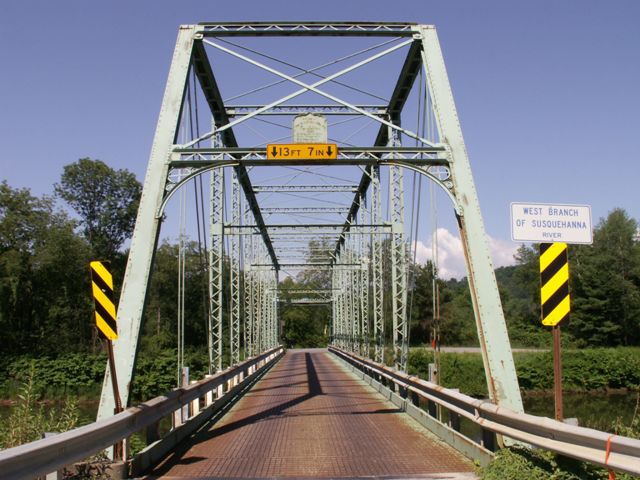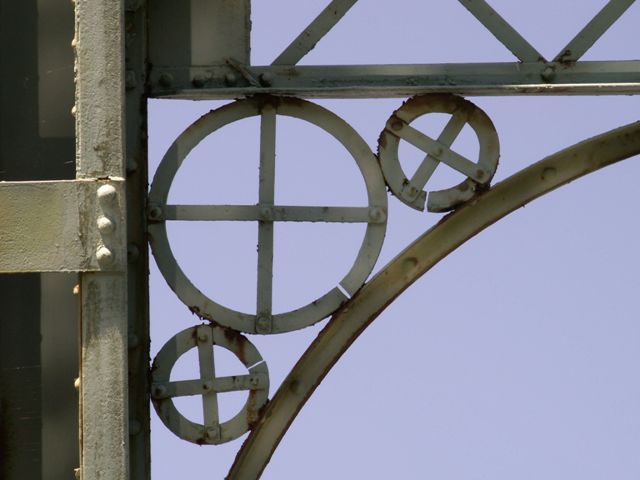We Recommend:
Bach Steel - Experts at historic truss bridge restoration.
Bells Landing Bridge

Primary Photographer(s): Nathan Holth and Rick McOmber
Bridge Documented: July 15, 2007
Redden Hill Road (PA-3005) Over West Branch Susquehanna River
Rural: Clearfield County, Pennsylvania: United States
1892 By Builder/Contractor: King Bridge Company of Cleveland, Ohio
Not Available or Not Applicable
194.0 Feet (59.1 Meters)
197.0 Feet (60 Meters)
13.8 Feet (4.21 Meters)
1 Main Span(s)
17722205660010

View Information About HSR Ratings
Bridge Documentation
This bridge no longer exists!
View Archived National Bridge Inventory Report - Has Additional Details and Evaluation
View The National Register of Historic Places Nomination Form For This Historic Bridge
This historic bridge was demolished in 2009 by PennDOT!
At nearly 200 feet in length, this bridge was an extremely long span for a pin-connected Pratt truss. Generally pin-connected spans of this length tend to be Whipple truss bridges. As such, the bridge was technologically significant as an extremely long spanning example of a simple pin-connected Pratt through truss The length of the bridge was why the trusses were relatively high and featured a more complex bracing system than other pin-connected through truss bridges. The bridge was also historically significant as a large and intact example of the prominent and historically important King Bridge Company of Cleveland, Ohio. The bridge stood out among surviving examples of King Bridge Company Bridges as a large and complete example of their work, and should have received high preservation priority as a result. The bridge enjoyed an extremely high degree of historic integrity. In addition, while it may have needed repair and was not currently sufficient for vehicular use, with large quantities of paint remaining on the bridge and section loss isolated to mainly the lower portions of the truss, this bridge was certainly a feasible bridge to restore for non-vehicular use. If preserved for non-vehicular use, this bridge could have stood for another entire century.
The Bells Landing Bridge was one of the most beautiful and important historic bridges in Clearfield County. Despite an extremely wide range of reasonable and feasible preservation solutions that would have avoided demolition, PennDOT wasted taxpayer dollars and destroyed an extremely significant historic structure that had been listed in the National Register of Historic Places since 1888, by demolishing this bridge. The historic bridge was not in the way of its replacement in any way, shape, or form. The utterly ugly new bridge was located on a significantly different alignment. Even with a general lack of sufficient historic bridge commitment exists nationwide, a bridge of this level of significance and integrity and not in the way of its replacement would have been preserved in one form or another if it had been located in a number of other states, such as New Jersey or Michigan. Pennsylvania however is a unique state in that it has the worst level of commitment to historic bridges in the entire country, despite one of the richest collection of historic bridges in the country. PennDOT is largely to blame for this very disappointing reputation. With ownership of a far larger percentage of roads (especially rural roads) compared to highway agencies in other states, PennDOT owns a large number of Pennsylvania's historic bridges. PennDOT enjoys quickly cutting through the thin red tape put in place by the federal government to protect historic bridges. Indeed, a pre-fabricated set of mitigation plans are ready to go for any historic bridge that PennDOT wants to demolish, which is pretty much all bridges, which generally include using low-profile guardrails, imitation stone stamps on the concrete substructure, and painting the beams of the new slab a weathered color, and sometimes putting up an interpretive sign about the historic bridge that they demolished.
Because the Bells Landing Bridge was not in the way of its replacement, there was absolutely no reason the bridge should have been demolished. If the bridge could not have been preserved for continued vehicular use, could not have been preserved in place for non-motorized use, could not have been relocated and preserved at a new location, could not have been turned into a one-way couplet with a new one-lane bridge, could not have been simply lifted off the abutments and set on the ground next to its replacement as a non-functional exhibit, could not have been dismantled and stored in a facility for future preservation in years to come, then the bridge should have at least been left standing in place with no further work done. Abandoned bridges in Michigan with severe structural deterioration and no paint have stood for decades without collapsing, and eventually people in Michigan decide the time and money is available and these abandoned bridges get preserved. Even if time and money was not available for preservation at the time of demolition, if PennDOT had left the bridge standing, it is very likely in several years after PennDOT has managed to eradicate every historic bridge from the Commonwealth, that people would have seen the value of the Bells Landing Bridge and a preservation project would have developed, perhaps even with private donations and fundraising, in addition to traditional sources like Transportation Enhancement grants.
In some ways, Pennsylvania proves its own methods false. It is worth noting that a large number of wooden covered bridges are preserved in Pennsylvania, or at least maintained. Many of these wooden covered bridges are functionally obsolete, since they are one-lane, have a weight limit, and a vertical clearance limitation. Yet they are allowed to remain on Pennsylvania's roads. This is clear discrimination against other types of historic bridges. HistoricBridges.org is not pretending that the Bells Landing Bridge was an extremely important historic bridge... the bridge was on the National Register of Historic Places since 1988. Therefore, there is no reason why Bells Landing Bridge, the rest of Pennsylvania's historic bridge types, including iron and steel truss bridges, concrete arch bridges, girder bridges, and stone arch bridges could not be preserved as well. Even if not for vehicular use, the least they could do is save money and leave the historic bridges standing next to their replacements.
The fact that this bridge was demolished was completely unacceptable. It is sickening to see tax dollars wasted on the demolition of such an important historic bridge. Why would anyone in their right mind want to spend even a single penny to destroy beautiful historic artifacts? And certainly, more than a penny of taxpayer dollars was spent to wipe this bridge off the face of the earth. The Bells Landing Bridge is a perfect example of why HistoricBridges.org exists and is proud to speak very clearly against PennDOT's current policy for historic bridges. The fact that so many covered bridges are preserved in the state but hardly any other historic bridge type only further galvanizes the cause.
Frank C. Osborn, whose photo is shown on this page, was Chief Engineer for King Bridge Company from 1889-1892.
![]()
Photo Galleries and Videos: Bells Landing Bridge
Structure Overview
Original / Full Size PhotosA collection of overview photos that show the bridge as a whole and general areas of the bridge. This gallery offers photos in the highest available resolution and file size in a touch-friendly popup viewer.
Alternatively, Browse Without Using Viewer
![]()
Structure Details
Original / Full Size PhotosA collection of detail photos that document the parts, construction, and condition of the bridge. This gallery offers photos in the highest available resolution and file size in a touch-friendly popup viewer.
Alternatively, Browse Without Using Viewer
![]()
Structure Overview
Mobile Optimized PhotosA collection of overview photos that show the bridge as a whole and general areas of the bridge. This gallery features data-friendly, fast-loading photos in a touch-friendly popup viewer.
Alternatively, Browse Without Using Viewer
![]()
Structure Details
Mobile Optimized PhotosA collection of detail photos that document the parts, construction, and condition of the bridge. This gallery features data-friendly, fast-loading photos in a touch-friendly popup viewer.
Alternatively, Browse Without Using Viewer
![]()
Maps and Links: Bells Landing Bridge
This historic bridge has been demolished. This map is shown for reference purposes only.
Coordinates (Latitude, Longitude):
Search For Additional Bridge Listings:
Bridgehunter.com: View listed bridges within 0.5 miles (0.8 kilometers) of this bridge.
Bridgehunter.com: View listed bridges within 10 miles (16 kilometers) of this bridge.
Additional Maps:
Google Streetview (If Available)
GeoHack (Additional Links and Coordinates)
Apple Maps (Via DuckDuckGo Search)
Apple Maps (Apple devices only)
Android: Open Location In Your Map or GPS App
Flickr Gallery (Find Nearby Photos)
Wikimedia Commons (Find Nearby Photos)
Directions Via Sygic For Android
Directions Via Sygic For iOS and Android Dolphin Browser
USGS National Map (United States Only)
Historical USGS Topo Maps (United States Only)
Historic Aerials (United States Only)
CalTopo Maps (United States Only)




